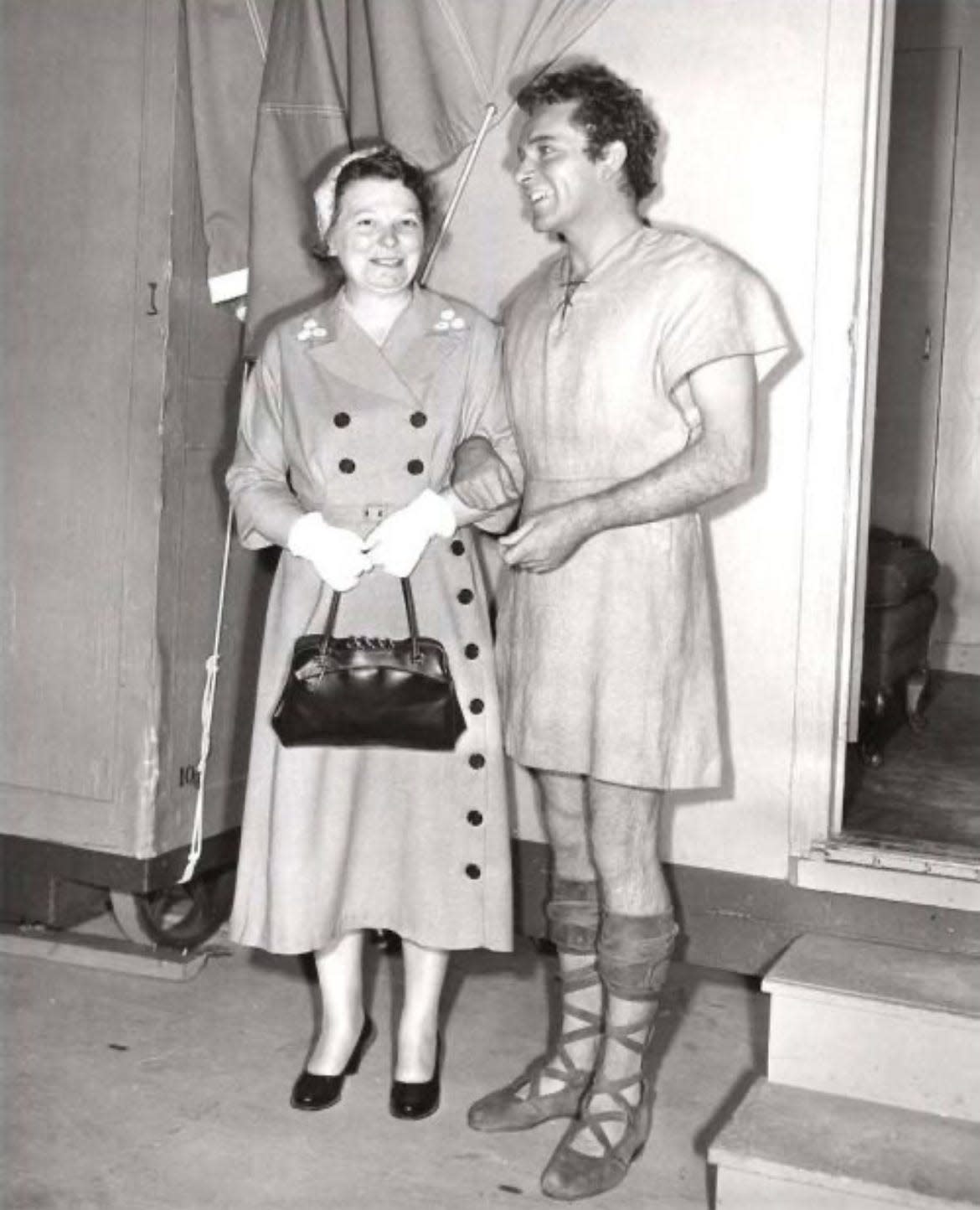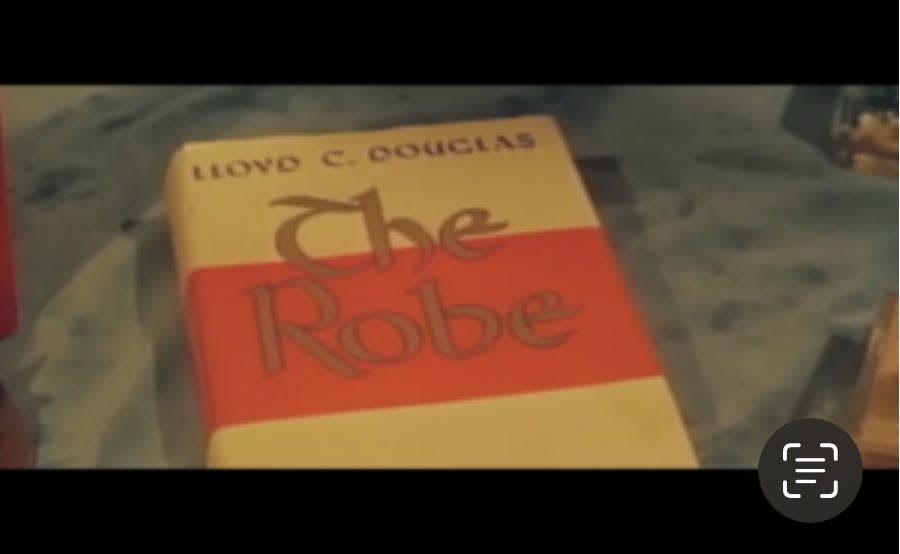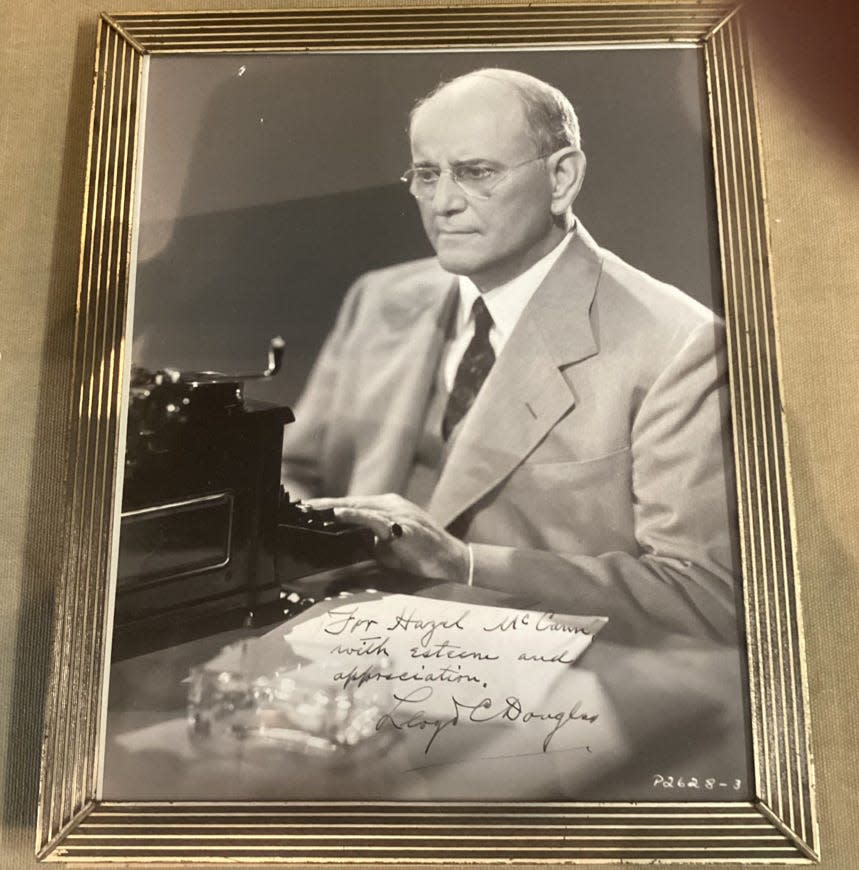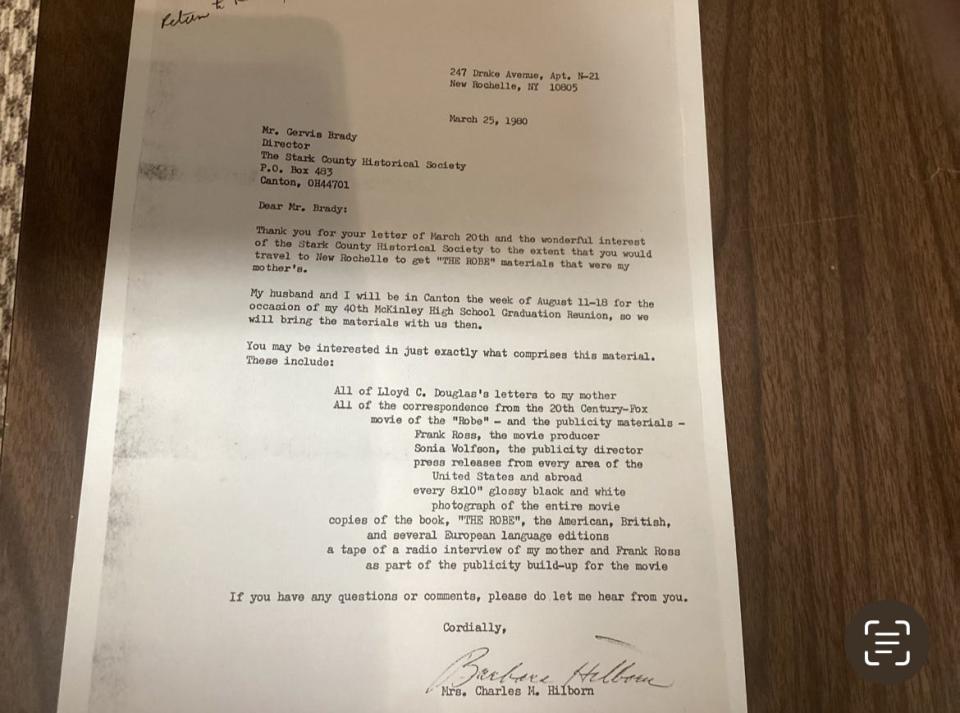Monday After: When a Canton woman inspired an Easter story

- Oops!Something went wrong.Please try again later.
"Then the soldiers, when they had crucified Jesus, took his garments, and made four parts, to every soldier a part; and also his coat. Now the coat was without seam, woven from the top throughout. They said, therefore, among themselves, 'let us not rend it, but cast lots for it, whose it shall be; that the scripture might be fulfilled ...'" – John 19:23-24.
As Good Friday and Easter approach, and the crucifixion and resurrection of Jesus Christ are in the minds of Christians, those words from the New Testament of the Bible take on special meaning in Stark County.
A perceptive letter from a Canton woman is said to have inspired both a book – "The Robe" by Lloyd C. Douglas was published in 1942 and sold more than two million copies – and the 1953 film by the same name starring Richard Burton, Jean Simmons and Victor Mature, which made $4.5 million for filmmakers.
"Mrs. Hazel McCann was the former Cantonian who gave minister and author Lloyd C. Douglas the idea for his novel, 'The Robe,'" documented "A Millennium Moment" recollection in The Canton Repository in 1999. "Producer Frank Ross bought the film rights before the book was half finished."
McCann's suggestion to Douglas was insightful and concise. She wondered in her letter what might have been the thinking of the soldiers who gambled for Christ's robe.
"What might have been the reaction of the winning soldier to the wearing of the coat?" Hazel McCann asked in her letter to Douglas dated Oct. 28, 1940. "There would be the recognition of that coat by the poor folk whom Jesus had helped. Would that not make a beautiful story?"
With her words, McCann would play a part not only in the course of literature, but in film history, as well. "The Robe" was made in a new filmmaking technique that was billed in one film advertisement as being so real for movie viewers that it was "3-D without the glasses."
"The very first CinemaScope movie (widescreen, using an anamorphic lens) was 'The Robe,'" explained M.J. Albacete, executive director emeritus of Canton Museum of Art, a longtime aficionado of films and an authority on 3-D movies who lived his teen-age years in Johnstown, Pennsylvania. "I was fascinated with the primitive 3-D movies of that era. ... I got permission to visit the projection booths at several movie houses, and got familiar with the polarized glasses you had to wear.
"I was in the auditorium the first day the film ('The Robe') was shown at Johnstown's classic Embassy Theatre."
Douglas, who went to Wittenberg University and later served a pastorate in Lancaster, Ohio, died in 1951 so he never got to see "The Robe" on screen. But, McCann remained in contact with both Douglas during his writing and filmmaker Frank Ross as he was making his movie.

Bible reading spawned suggestion
McCann, a daily Bible reader and a housewife who worked as a clerk in a department store while she was living in Canton, once explained how she found her place in literary and cinema history.
According to a profile of the Canton woman published in the paper in 1954, she was reading the 19th chapter of the Book of John when she wondered how the robe worn by Jesus might have influenced the lives of the soldiers who cast lots for it. So, prompted by "a small voice" in the back of her mind, McCann scribbled a note and mailed it to Douglas, an author with whose writing style she was familiar.
"I had read several books written by Mr. Douglas," she said 70 years ago, "and I thought he was the author to handle such a theme. He replied to my letter saying he thought the idea had great possibilities. Later, he sent an outline of the story he intended to write."
McCann stressed in her correspondence with Douglas that his book should emphasize that Christ's robe possessed no supernatural qualities. Those who owned it after Christ's death merely "were influenced by the fact that it had been worn by Christ." Douglas' writing in the novel reflected that central idea.
The author kept McCann apprised of his progress in writing the 472 pages of "The Robe" through letters, missives in which he encouraged her advice.
"I am glad you are liking the novel," Douglas said in a 1941 letter. "Your queries and suggestions are, I think, quite thoughtful and pertinent."
The correspondence between author and his muse blossomed into a friendship. He came to know McCann's family. He dined with them once in the former Belden Hotel. McCann visited him and his wife in Cleveland, New York and Los Angeles as the book was being completed.

Movie debuted in Canton
During its first week of showing, the movie made from "The Robe" – a film that won five Academy Awards – played to a record-breaking audience that totaled more than 26,000 people at its showings in Canton. It made more money in the Palace Theatre during initial showings than such films as Walt Disney's "Peter Pan" or the classic "Gone With the Wind."
Ralph Russell, manager of the Palace in 1953, decided that a scrapbook should be set up in the lobby of the theater to record the feelings of viewers of the movie in McCann's hometown.
"I do believe through you God has talked to us again," one signer said.
"Our Lord must have given you the inspiration," another viewer reasoned.
One note came from McCann's sister, Mrs. William Lintner of Canton, and another from the grandmother of Stark County-born movie actress Peggy Ann Garner, Mrs. Phoebe A. Garner.
A third note offered a "small-world" revelation that "my father and Lloyd Douglas were classmates at Wittenberg.
Russell passed the scrapbook on to McCann, who had moved to Almeda, California, before the film was released. She died there in 1960, and an obituary published May 31, 1960, in The Oakland Tribute identified her again as the inspiration for the writing of "The Robe."
The obit noted that Douglas not only thanked McCann for her part in creating the story, but also gave her $2,500 from the profits of the book.
"And when ‘The Robe’ was made into a multi-million dollar wide-screen film utilizing 10,000 persons, Mrs. McCann was honored on the 20th Century-Fox Studio sets in Hollywood," the obituary said.

Museum retains McCann collection
Following her mother's passing, her daughter, Barbara Hilborn of New Rochelle, New York, donated material her mother had collected concerning "The Robe" and her connection to it. A picture of McCann with Richard Burton is among three boxes of material.
"I found the boxes one day years ago, when we were just snooping around," said Tom Haas, a volunteer in McKinley museum's Ramsayer Research Library. "What was in the boxes was unlike anything I've seen. They contained movie stills. Pictures of actors posing with McCann. There were letters back and forth between her and Douglas. I found pictures of Douglas that he gave to her, each with a nice message. And there were newspaper articles (about the book and movie) from throughout the country. Just about every major newspaper had written about them, as did a lot of magazines.
"It was an unusual find, one that made me ask, 'What does all this have to do with Canton?'"
One of the boxes was separated for a time from the others, noted Haas and fellow volunteer Judy Gouge, who not long ago rediscovered the missing box in the Ramsayer library.
"I was totally thrilled with finding all those pictures of the film and cast," said Gouge, who added she had not read the book, but had seen the movie, which was from her youthful days of movie-watching. "I was enthralled."
Also in one of the boxes was a copy of Douglas' book. A reader need leaf through only a few preliminary pages of the novel to find published evidence of McCann's influence over the author's writing.
The dedication page singles out the Canton woman.
McCann had known ahead of time that the author was going to dedicate his work to her. He had asked her for her first name.
McCann didn't like the name "Hazel," and had signed her initial letter to him – and subsequent correspondence – using "Mrs." along with her husband's name.
One day far into his writing of the book, the author asked her "Don't you have any other name?"
"After all," Douglas explained, "the book would look queer dedicated to 'Mrs. James McCann."
Instead, the dedication page includes not only her name, but the reason for its title.
"Dedicated with appreciation to Hazel McCann, who wondered what became of the robe."
Reach Gary at gary.brown.rep@gmail.com. On Twitter: @gbrownREP.
This article originally appeared on The Alliance Review: Canton woman Hazel McCann's letter inspired book, Oscar-winning movie

